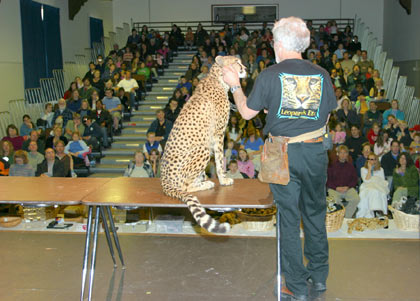When I heard that there was a wild cat show at the Rio Theater, I thought about how much I love cats, I thought about how busy we were, and I thought about how there was some incident…
Then the publisher of Santa Cruz Parent asked me if I wanted tickets.

What can I say? I love cats. I love my three heat-seeking love units (i.e. domesticated cats). I love to see big ones from a distance and imagine touching their beautiful coats. But I’m also a wimp, and thus did not become a big cat handler. I’m a big cat handler wanna-be.
So the Wild Cat Adventure is just about perfect for me. Sure, I still wanted to stroke their coats, but seeing them up close was almost as good. Let me tell you: these cats are gorgeous. And they aren’t stressed out in a zoo, pacing around in their cages, lolling around like they’re drugged or just checked out. These cats are engaged, and so are their presenters. It’s quite a show.
Barbara and Rob, a wife and husband duo, talk on the stage and bring out the cats one by one. Barbara does most of the talking, Rob most of the handling. It’s clear that they respect the cats and understand them and care for them. As Rob said, “We love them; they use us.”
The five cats we got to see were a Canada lynx, a cheetah, a serval cat, a Geoffrey’s cat, and a California mountain lion. All of the cats were born in captivity and the presenters were deeply knowledgeable about their role in the animals’ lives. They explained that their main goal was education: they want to bring these cats into people’s lives so that we can learn about them in the wild and understand what is happening to them.
They offered tidbits of knowledge about each animal, much of which I, a cat lover, didn’t know: Our bobcats are lynxes. Cheetahs are diurnal so that they won’t be eaten by nocturnal lions. What we call a mountain lion has 65 different names because its original habitat was across all of North America, and each local tribe gave it a different name.
They also gave a glimpse inside the psychology of each animal. The serval cat is a mouse-catcher, so they tempt it to hunt by presenting a piece of raw chicken at the bottom of a tube (their simulation of a mouse hole). The Geoffrey’s cat looks like a house cat (though more beautiful than any tabby aspires to), but is a biter. Rob said, “I respect these cats and I never turn my back to them.” No kidding.
They explained that our feelings for the cats are not reciprocated. What we saw as the cats being affectionate with them was the cats marking their territory. They explained why cats get shot by ranchers and why people think cats are getting more dangerous, when really it’s the other way around.
We, they pointed out to us, are the fiercest predator. We have a mythology of fear of cats, but we are running them out of their native lands, hunting them to extinction. The tiny Geoffrey’s cat with its gorgeous coat has been hunted nearly to extinction for the value of its tiny furs.

“Can you imagine how many of these cats it takes to make a coat?” they asked.
The children in the audience were in awe. When the first cat, the lynx, jumped up on the table, a quiet, awesome, “Ah” rose from the audience. This was much closer to religion than entertainment. This was not the circus of our childhoods, in which the big cats were dominated by the man with the whip. Rob clearly understood each cat. Though the kids didn’t notice, I noticed that when he had his biggest, heaviest, fiercest cat — our mountain lion — on the table, it was on a white-knuckled, four-inch lead.
As we left the house, my husband joked, “Don’t sit in the front row.” But I have to say I wasn’t concerned at all throughout the show, even for our friends who really were in the front row. At the opening they explained that they won’t show any cat over one hundred pounds (half of Don’s weight), and that they wanted us to follow some rules about what not to do to excite or scare the animals. Though they clearly cared about the audience, their greatest concern was for the comfort of the cats, which would determine the safety of the audience. They refused to start the show till all the house lights were brought up so that the cats wouldn’t be greeted with shadows, which spook them.
I felt like we were in an ancient temple, with the awesome power of nature in front of us. Unfortunately, given what we’ve done to nature, it was more like a museum, like the Temple of Dendur inside the Metropolitan Museum in New York. There was a sadness to the presentation, underneath the worship and amazement. As they told us over and over, we can’t live with these animals. They are predators, and they need their own space to thrive. Our challenge is to figure out how we can do that for them, simply because it’s the right thing to do.